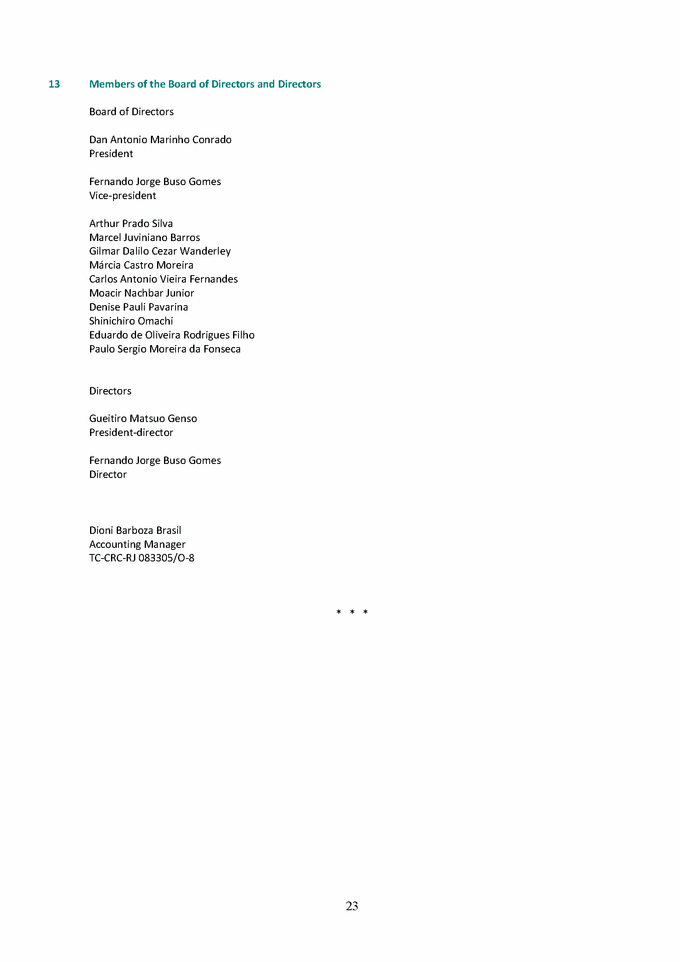- VALE Dashboard
- Financials
- Filings
-
Holdings
- Transcripts
- ETFs
-
Insider
- Institutional
- Shorts
-
SC TO-C Filing
Vale (VALE) SC TO-CInformation about tender offer
Filed: 15 May 17, 12:00am
Exhibit 7
ValeparS.A. Financial Statements December 31, 2016 (A free translation of the original report issued in Portuguese containing Financial Statements prepared in accordance with accounting practices adopted in Brazil)
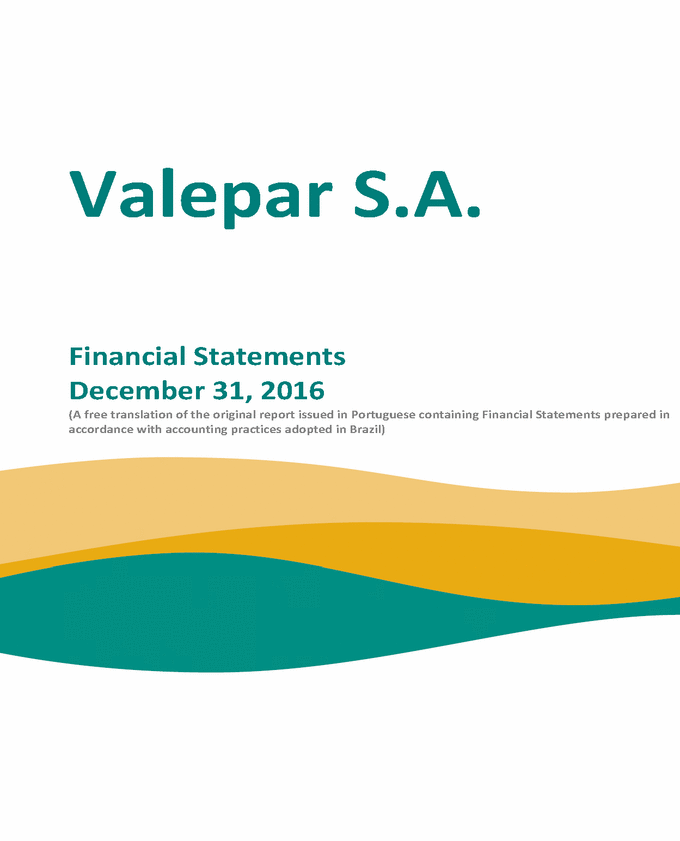
Valepar S.A. Financial Statements Contents Page Statement of Income 7 Statement of Cash Flows 9 Statement of Changes in Equity 11 Notes to the Financial Statements 13 2 Members of the Board of Directors and Directors24 Statement of Value Added12 Balance Sheet10 Statement of Comprehensive Income8 Independent auditors’ report3
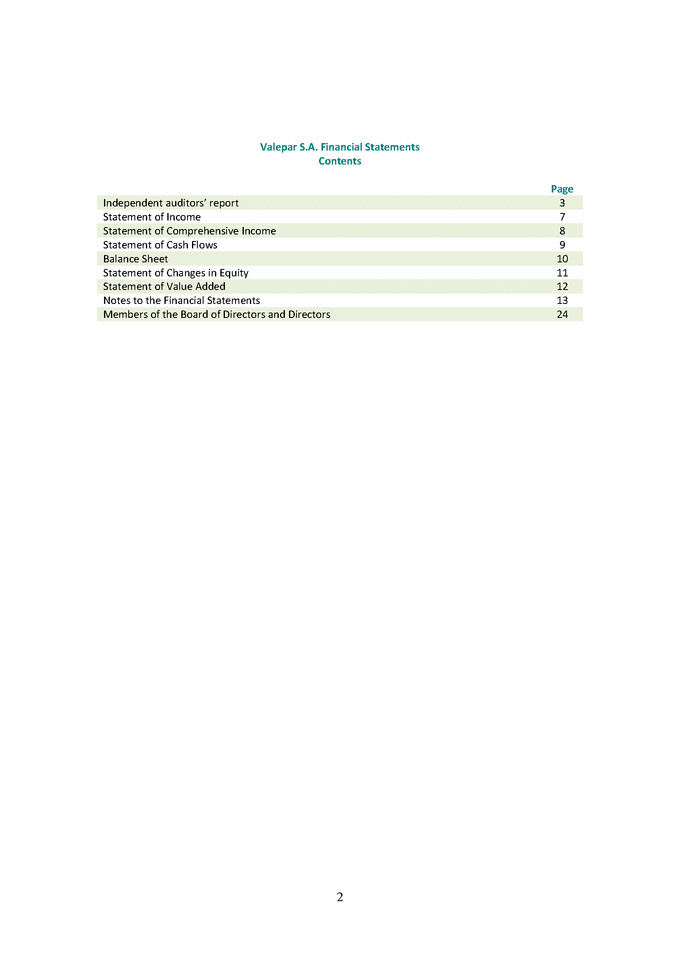
KPMG Auditores Independentes Av. Almirante Barroso, 52 - 4º andar 20031-000 - Rio de Janeiro/RJ - Brasil Caixa Postal 2888 - CEP 20001-970 - Rio de Janeiro/RJ - Brasil T. 55 (21) 3515-9400, Fax 55 (21) 3515-9000 www.kpmg.com.br Independent auditors’ report (A free translation of the original report issued in Portuguese containing Financial Statements prepared in accordance with accounting practices adopted in Brazil) To Management and Shareholders of Valepar S.A. Rio de Janeiro - RJ Opinion We have audited the individual financial statements of Valepar S.A. (“the Company”), which comprise the statements of income, comprehensive income and cash flows for the year ended December 31, 2016, and the balance sheet and statement of changes in equity for the year then ended, as well as the notes to the financial statements, including significant accounting policies and other explanatory information. In our opinion, the individual financial statements present fairly, in all material respects, the financial position of Valepar S.A. as of December 31, 2016, and its individual financial performance and individual cash flows for the year then ended in accordance with accounting practices adopted in Brazil. Basis for opinion We conducted our audit in accordance with Brazilian and International Standards on Auditing. Our responsibilities under those standards are further described in the Auditors' Responsibilities for the Audit of the Financial Statements section of our report. We are independent of the Company in accordance with the ethical requirements of the Professional Code of Ethics for Accountants issued by Federal Accounting Council, and we have fulfilled our ethical responsibilities in accordance with these requirements. We believe that the audit evidence we have obtained is sufficient and appropriate to provide a basis for our audit opinion. Emphasis of a matter Without qualifying our report further, we draw your attention to Note 12, which indicates that a new Company shareholders’ agreement was entered into providing for, among other matters, a proposal to transform the subsidiary Vale S.A. (“Vale”) into a company without specific control, and other stages that involve the restructuring of the other companies of the group, particularly the Company's merger into Vale. At the current stage, we are neither able to determine which will be the outcome of this matter nor the potential impacts, if any, on the Company. KPMG Auditores Independentes, uma sociedade simples brasileira e firma-membro da rede KPMG de firmas-membro independentes e afiliadas à KPMG International Cooperative (“KPMG International”), uma entidade suíça. KPMG Auditores Independentes, a Brazilian entity and a member firm of the KPMG network of independent member firms affiliated with KPMG International Cooperative (“KPMG International”), a Swiss entity. 3
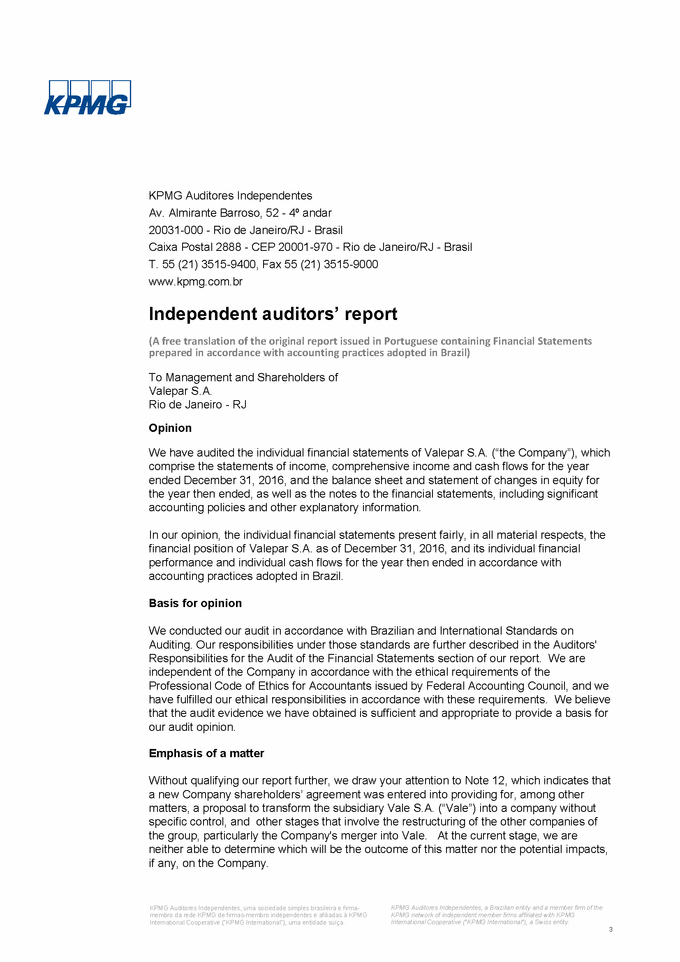
Other matters - Consolidated financial statements Valepar S.A. has prepared a full set of consolidated financial statements for the year ended December 31, 2016 in accordance with Brazilian accounting policies and international financial reporting standards (IFRS) issued by the International Accounting Standards Board (IASB), which are presented separately, on which we issued a separate unqualified independent auditors` report on March 15, 2017. This full set of financial statements also includes the consolidated statement of value added for the year ended December 31, 2016, which is presented herein as supplementary information for IFRS purposes. Other matters - statement of value added The individual statement of value added for the year ended December 31, 2016, prepared under the responsibility of the Company's management, and presented as supplementary information for IFRS purposes, were submitted to audit procedures followed simultaneously with the audit of the Company's financial statements. In order to form our opinion, we evaluated whether this statement is reconciled to the Company's financial statements and accounting records, as applicable, and whether their form and content are in accordance with the criteria set on Technical Pronouncement CPC 09 - Statement of Value Added. In our opinion, this statement of value added has been adequately prepared, in all material respects, according to the criteria set on this Technical Pronouncement and is consistent with the individual financial statements taken as a whole. Responsibilities of management and those charged with governance for the financial statements Management is responsible for the preparation and fair presentation of the individual financial statements in accordance with Brazilian accounting policies, and for such internal control as management determines is necessary to enable the preparation of the individual financial statements that are free from material misstatement, whether due to fraud or error. In preparing the individual financial statements, management is responsible for assessing the Company’s ability to continue as a going concern, disclosing, as applicable, matters related to going concern and using the going concern basis of accounting to prepare the individual financial statements, unless management either intends to liquidate the Company or to cease operations, or has no realistic alternative but to do so. Those charged with governance are responsible for overseeing the Company’s financial reporting process. KPMG Auditores Independentes, uma sociedade simples brasileira e firma-membro da rede KPMG de firmas-membro independentes e afiliadas à KPMG International Cooperative (“KPMG International”), uma entidade suíça. KPMG Auditores Independentes, a Brazilian entity and a member firm of the KPMG network of independent member firms affiliated with KPMG International Cooperative (“KPMG International”), a Swiss entity. 4
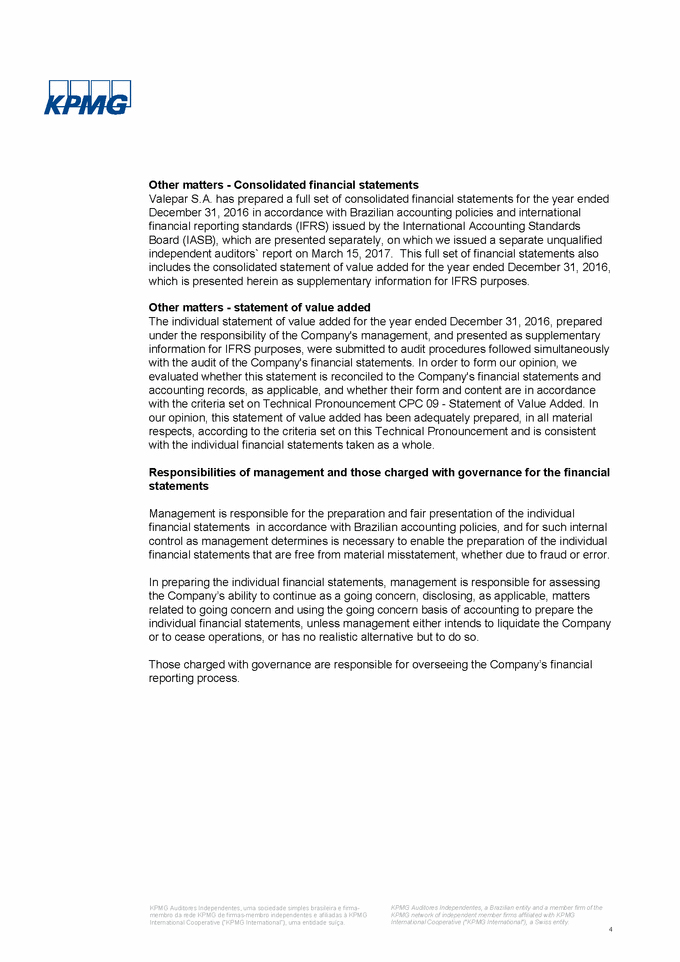
Auditors’ Responsibilities for the Audit of the Financial Statements Our objectives are to obtain reasonable assurance about whether the individual financial statements as a whole are free from material misstatement, whether due to fraud or error, and to issue an auditors’ report that includes our opinion. ‘Reasonable assurance’ is a high level of assurance, but is not a guarantee that an audit conducted in accordance with International and Brazilian Standards on Auditing will always detect a material misstatement when it exists. Misstatements can arise from fraud or error and are considered material if, individually or in aggregate, they could reasonably be expected to influence the economic decisions of users taken on the basis of these individual financial statements. As part of an audit in accordance with International and Brazilian Standards on Auditing, we exercise professional judgment and maintain professional skepticism throughout the audit. We also: • Identify and assess the risks of material misstatement of the individual financial statements, whether due to fraud or error, design and perform audit procedures responsive to those risks, and obtain audit evidence that is sufficient and appropriate to provide a basis for our opinion. The risk of not detecting a material misstatement resulting from fraud is higher than for one resulting from error, as fraud may involve collusion, forgery, intentional omissions, misrepresentations or the override of internal control. • Obtain an understanding of internal control relevant to the audit in order to design audit procedures that are appropriate in the circumstances, but not for the purpose of expressing an opinion on the effectiveness of the Company’s internal control. • Evaluate the appropriateness of accounting policies used and the reasonableness of accounting estimates and related disclosures made by management. • Conclude on the appropriateness of management’s use of the going concern basis of accounting and, based on the audit evidence obtained, whether a material uncertainty exists related to events or conditions that may cast significant doubt on the Company’s ability to continue as a going concern. If we conclude that a material uncertainty exists, then we are required to draw attention in our auditors’ report to the related disclosures in the individual financial statements or, if such disclosures are inadequate, to modify our opinion. Our conclusions are based on the audit evidence obtained up to the date of our auditors’ report. However, future events or conditions may cause the Company to cease to continue as a going concern. • Evaluate the overall presentation, structure and content of the individual financial statements, including the disclosures, and whether the individual financial statements represent the underlying transactions and events in a manner that achieves fair presentation. • Obtain sufficient appropriate audit evidence regarding the financial information of the entities or business activities within the Group to express an opinion on the financial statements. We are responsible for the direction, supervision and performance of the group audit. We remain solely responsible for our audit opinion. KPMG Auditores Independentes, uma sociedade simples brasileira e firma-membro da rede KPMG de firmas-membro independentes e afiliadas à KPMG International Cooperative (“KPMG International”), uma entidade suíça. KPMG Auditores Independentes, a Brazilian entity and a member firm of the KPMG network of independent member firms affiliated with KPMG International Cooperative (“KPMG International”), a Swiss entity. 5
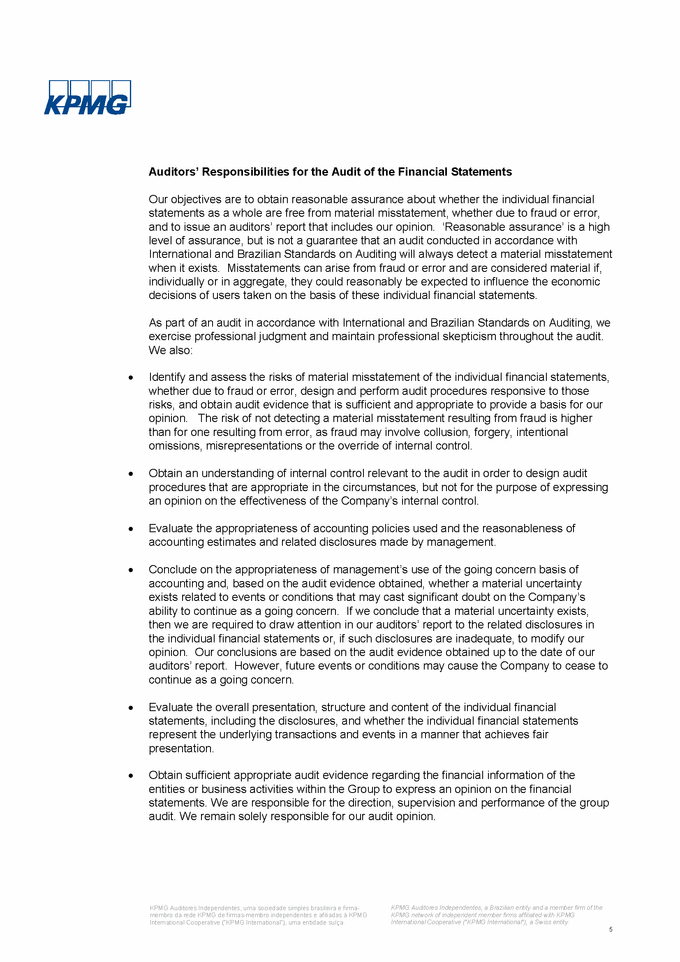
We communicate with those charged with governance regarding, among other matters, the planned scope and timing of the audit and significant audit findings, including any significant deficiencies in internal control that we identify during our audit. Rio de Janeiro, March 15, 2017 KPMG Auditores Independentes CRC SP-014428/O-6 F-RJ Original report issued in portuguese signed by Bernardo Moreira Peixoto Neto Accountant CRC RJ-064887/O-8 KPMG Auditores Independentes, uma sociedade simples brasileira e firma-membro da rede KPMG de firmas-membro independentes e afiliadas à KPMG International Cooperative (“KPMG International”), uma entidade suíça. KPMG Auditores Independentes, a Brazilian entity and a member firm of the KPMG network of independent member firms affiliated with KPMG International Cooperative (“KPMG International”), a Swiss entity. 6
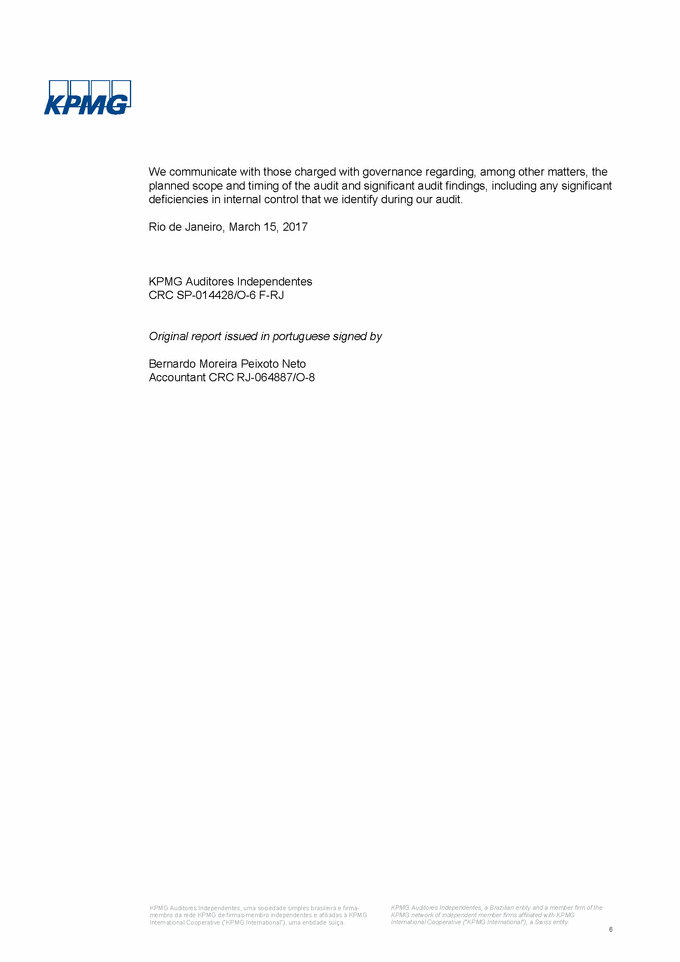
Valepar S.A. Statement of Income Year ended December 31 In thousand of Brazilian Reais, except as otherwise stated Notes 2016 2015 Equity results from subsidiary 4 4,486,187 (14,900,259) Operating (expenses) Income, net Provision for litigation 5 - 541,121 Financial result 8 38,759 58,951 Net income (loss) before income taxes 4,493,055 (14,303,582) Income taxes 10 (1,013) (33,579) Net income (loss) 4,492,042 (14,337,161) Basic and diluted earnings (loss) per share The management’s accompanying notes are an integral part of these individual financial statements. 7 Preferred and common shares (R$)6 (d)2.84(9.06) (31,891)537,726 Administrative expenses(31,891)(3,395) Equity results
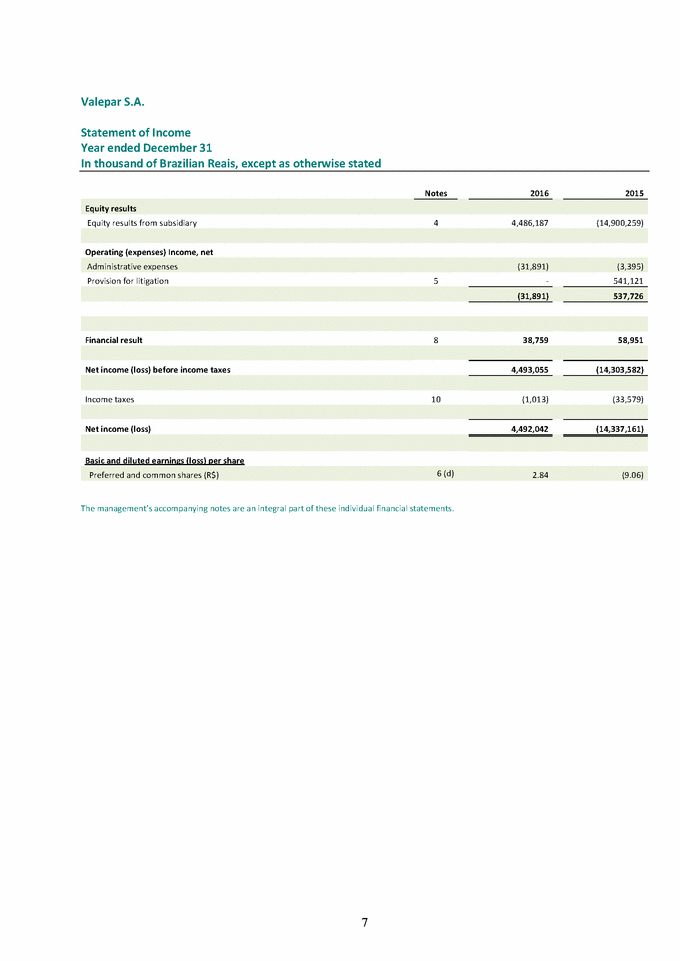
Valepar S.A. Statement of Comprehensive Income Year ended December 31 In thousand of Brazilian Reais Net income (loss) 4,492,042 (14,337,161) Items that will not be reclassified subsequently to the income statement Gross balance (54,946) (45,117) Equity results in entities, net of taxes (52,238) 117,023 Reflected cumulative translation adjustments (4,476,581) 11,596,079 (4,566,228) 11,596,079 Reflected non-realized gain (loss) in available-for-sale investments: 1,229 863 Reflected cash flow hedge Effect of taxes (904) (7,751) Transfer of realized results to net income, (3,423) (389,910) Total of items that may be reclassified subsequently to the income statement (4,556,319) 12,088,293 The management’s accompanying notes are an integral part of these individual financial statements. 8 Total comprehensive income (loss)(152,925)(2,161,356) 8,680491,351 Equity results in entities, net of taxes5,002(5,729) Gross balance8,005894,741 Gross balance1,229863 Transfer of realized results to net income(89,647)-Items that may be reclassified subsequently to the income statement Total items that will not be reclassified subsequently to the income statement(88,648)87,512 Effect of taxes18,53615,606 Reflected retirement benefit obligations Other comprehensive income (loss): 20162015
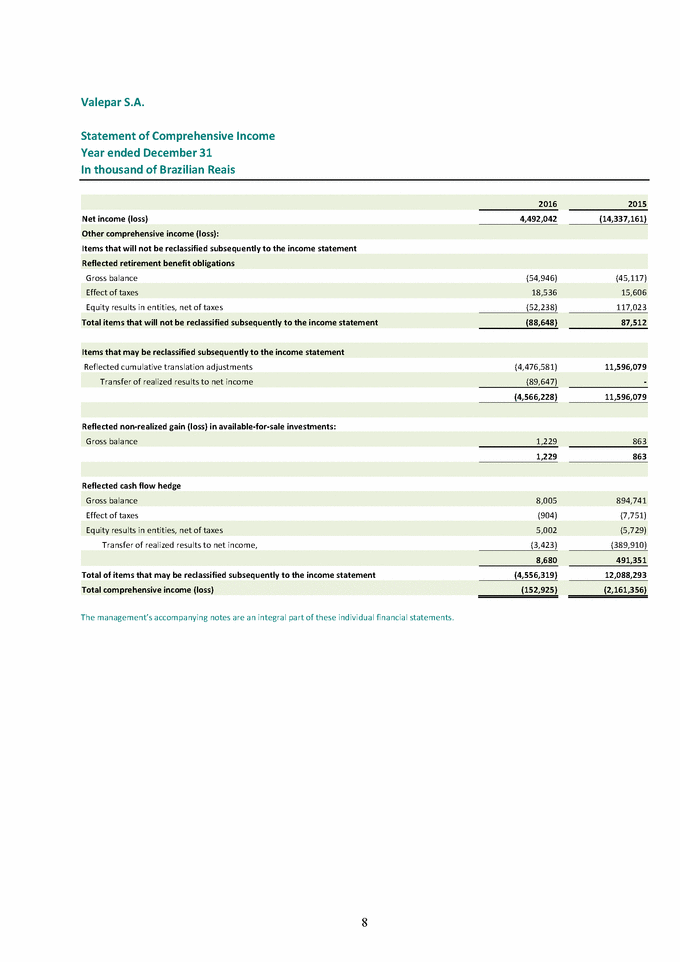
Valepar S.A. Statement of Cash Flows Year ended December 31 In thousand of Brazilian Reais Cash flow from operating activities Operations adjusted for: Provision for litigation - (541,121) Monetary indexation, net (31,916) (151,521) Prepaid expenses - insurance 1,659 (6,866) Judicial deposits - (96,674) Interest in redeemable shares - 98,788 Dividends and interest on capital received 245,493 1,537,231 interest on capital paid to redeemable shares - (127,478) Liquidation of redeemable shares - (1,118,574) The management’s accompanying notes are an integral part of these individual financial statements. 9 Cash and cash equivalents at end of the year35,6019,460 Cash and cash equivalents in the beginning of the year9,4608,095 Increase in cash and cash equivalents26,1411,365 Net cash used in financing activities(214,278)(1,435,052) Dividends and interest on capital paid to stockeholders(214,278)(189,000) Financing activities Net cash provided by operating activities240,4191,436,417 Others(637)5,874 Accounts payable - REFIS254355 Recoverable income taxes(7,004)27,253 Changes in assets and liabilities: Provision for pis/cofins26,715-Equity results from subsidiary(4,486,187)14,900,259 Net income (loss)4,492,042(14,337,161) 20162015
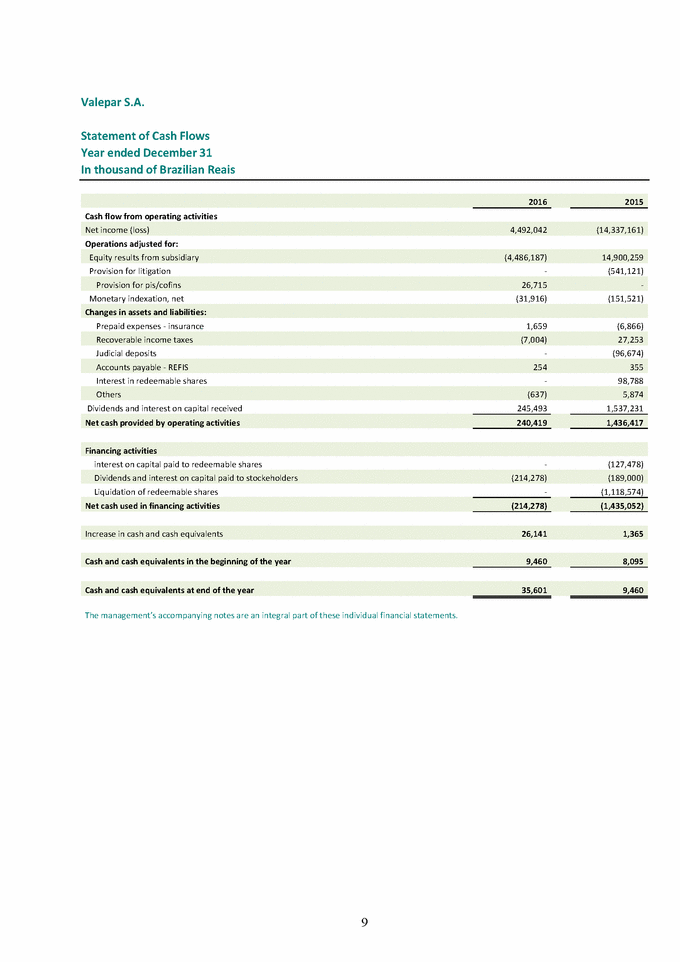
Valepar S.A. Balance Sheet Year ended December 31 In thousand of Brazilian Reais Assets Notes 2016 2015 Cash and cash equivalents 3 35,601 9,460 Others 1,658 1,658 Recoverable income taxes 94,300 86,213 Investments 4 45,954,891 47,275,894 48,812,043 49,955,137 Payable interest on capital 6 (c) 31,215 - Provision for pis/cofins 26,715 - 60,936 2,705 Accounts payable to shareholders 47,989 46,906 Provision for litigation 5(a) 1,756,283 1,616,718 2,222,338 2,082,374 Stockholders' equity Profit reserves 20,778,258 16,575,031 47,443,029 47,881,176 The management’s accompanying notes are an integral part of these individual financial statements. 10 Total liabilities and stockholders' equity49,726,30349,966,255 Reflected equity adjustments12,532,04617,173,420 Share capital6 (a)14,132,72514,132,725 Others3,3124,152 Accounts payable - REFIS9414,754414,598 Non-current liabilities Others2,0131,809 Accounts payable - REFIS9993896 Current liabilities Liabilities and stockholders' equity20162015 Total assets49,726,30349,966,255 Others3,9875,646 Judicial deposits5(b)2,758,8652,587,384 Non-current assets 914,26011,118 Receivable interest on capital4877,001-Current assets
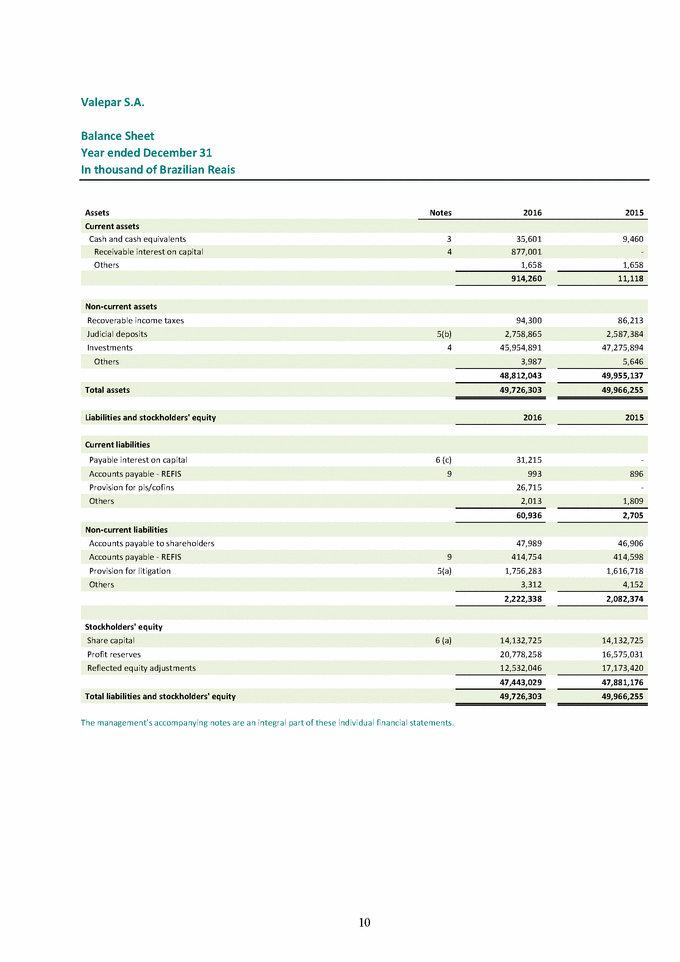
Valepar S.A. Statement of Changes in Equity In thousand of Brazilian Reais Share capital Legal To realize Reflected equity adjustments Retained earnings Total Share capital increase (note 6a) 2,505,500 2,505,500 Reflected adjustments of the subsidiary Vale S.A. Translation adjustments - - - 11,596,079 - 11,596,079 Retirement benefit obligations - - - 87,513 - 87,513 Realization of reserves - - (15,287,661) 15,287,161 (500) Balance at December 31, 2015 14,132,725 1,561,507 15,013,524 17,173,420 - 47,881,176 Reflected adjustments of the subsidiary Vale S.A. Translation adjustments - - - (4,566,228) - (4,566,228) Retirement benefit obligations - - - (88,648) - (88,648) Interim interest on capital - - - - (288,815) (288,815) Appropriation to profit reserves 224,602 3,978,625 (4,203,227) - The management’s accompanying notes are an integral part of these individual financial statements. 11 Balance at December 31, 201614,132,7251,786,10918,992,149 12,532,046-47,443,029 Appropriation of the net income: Result in subsidiary’s interest variation---3,593-3,593 Cash flow hedge---8,680-8,680 Non-realized results in available-for-sale investments---1,229-1,229 Net Income of the year ----4,492,0424,492,042 Interim interest on capital----(950,000)(950,000) Result in subsidiary’s interest variation---(722,561)-(722,561) Cash flow hedge---491,351-491,351 Non-realized results in available-for-sale investments---863-863 Loss of the year----(14,337,161)(14,337,161) Balance at December 31, 201411,627,2251,561,50730,301,185 5,720,175-49,210,092 Profit reserves
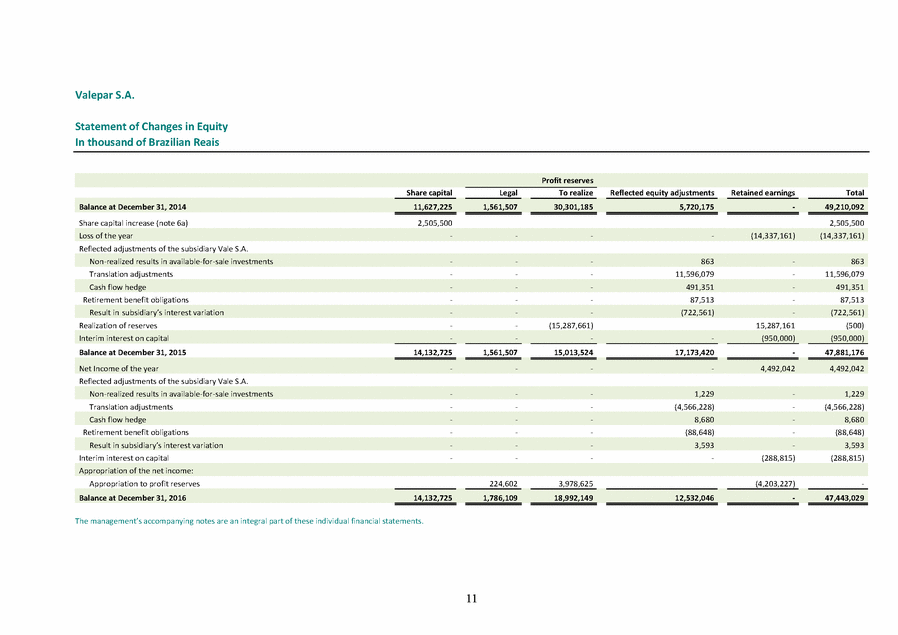
Valepar S.A. Statement of Value Added Year ended December 31 In thousand of Brazilian Reais 2016 2015 Provision for litigation - 541,121 Net value added (31,891) 537,726 Received by the Company Equity results from subsidiary 4,486,187 (14,900,259) Remuneration to third party Income taxes 1,013 33,579 Reinvested net income (accumulated loss) 4,203,227 (15,287,161) The management’s accompanying notes are an integral part of these individual financial statements. 12 Distributed value added (retained)4,495,984(14,353,423) Dividends and interest on capital288,815950,000 Financial expense2,929(49,841) Distributed value added Total value added to be distributed (retained)4,495,984(14,353,423) Financial income41,6889,110 Other revenues (expenses)(31,891)(3,395) Operating expenses
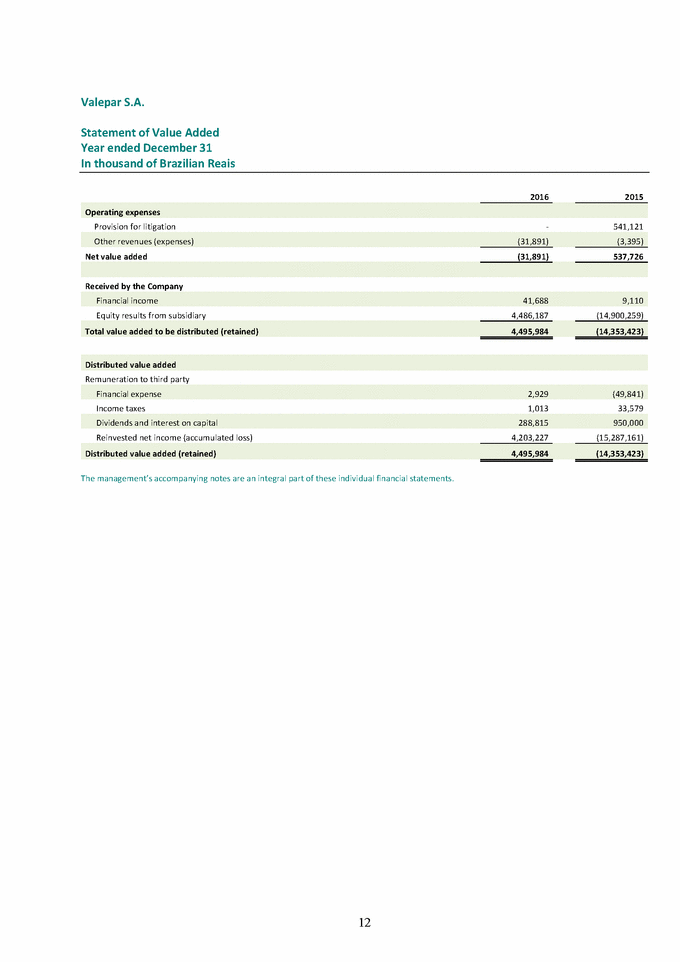
Valepar S.A. Management’s accompanying notes of the individual financial statements at December 31, 2016 In thousand of Brazilian Reais, except as otherwise stated 1 Corporate information Valepar S.A. (“Company”) was incorporated at April 9, 1997 and is a private company headquartered at Rio de Janeiro. The Company's sole purpose is to participate as a shareholder of Vale S.A. ("Vale"), of which it is the parent company. On February 20, 2017, Valepar's stockholders announced the intention to merge Valepar into Vale, as mentioned in note 12 (subsequent event). 2 Summary of the main accounting policies The individual financial statements of Valepar S.A. (“financial statements”) have been prepared in accordance with the accounting practices adopted in Brazil as issued by Brazilian Accountant Pronouncements Committee ("CPC"). 2.1 Basis for preparation and presentation The preparation of financial statements requires the use of certain critical accounting estimates and judgments by the management of the Company in the process of application of the accounting policies. The financial statements have been prepared under the historical cost convention as adjusted to reflect: (i) the fair value of financial instruments measured at fair value through income statement or available-for-sale financial instruments measured at fair value through the statement of comprehensive income; and (ii) impairment of assets. The Company prepared its consolidated financial statements for the year ended December 31, 2016 in accordance with accounting practices adopted in Brazil and the International Financial Reporting Standards ("IFRS") issued by the International Accounting Standards Board ("IASB"), presented separately from these individual financial statements. These individual financial statements should be read together with the consolidated financial statements. The Directors authorized the issuance of these financial statements on March 15, 2017. Functional and presentation currencies The financial statements of the Company are measured and presented using the currency of the primary economic environment that the Company operates, in which is Brazilian Real (“R$”). The Company did not transactioned in a currency other than the functional currency. 2.2 Cash and cash equivalents The amounts recorded as cash and cash equivalents correspond to the amount available in cash, bank deposits and short-term investments that have immediate liquidity and original maturities within three months and insignificant risk of variation on its fair value. 13
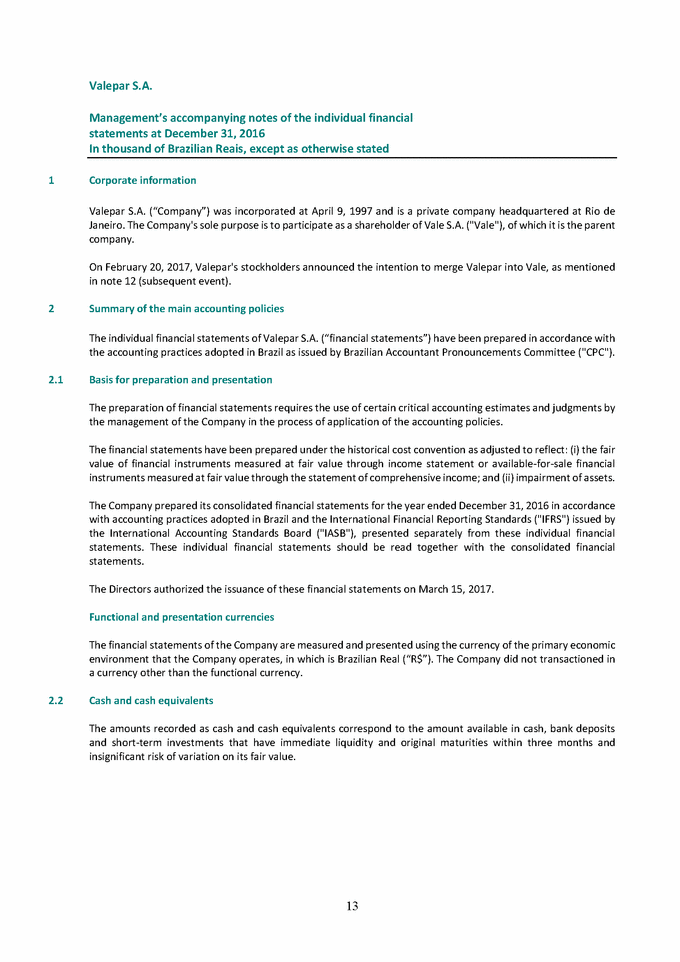
2.3 Investment in controled entity Controlled entity is the entity in which the Company has the power to determine financial and operating policies (voting capital). The existence and effect of possible voting rights currently exercisable or convertible are considered when evaluating whether the Company controls another entity. Investments in subsidiaries is accounted in the individual financial statements of the Company using the equity pick up method. The initial value is recognized at acquisition cost and the goodwill paid. Subsequently, such investments are accrued by the Company's interest in the investee's results and comprehensive income, as well as reflected adjustments to shareholders' equity. This method will be suspended from the date on which the Company no longer has control or significant influence over the investee. In the event that the equity method is suspended, the investment would be treated as a financial instrument held for sale and valued at market value. 2.4 Financial assets 2.4.1 Classification The Company classifies its financial assets as loans and receivables, which are measured at amortized cost. The classification depends on the purpose for which the financial assets were acquired. The management determines the classification of the financial assets in the initial recognition. 2.4.2 Receivables The receivables are non-derivative financial assets with fixed or defined payments, which are not quoted in an active market. They are classified as current assets, except those with a maturity of more than 12 months from the end of the reporting period (those are classified as non-current assets). The Company's receivables comprise "cash and cash equivalents" and "judicial deposits". 2.5 Impairment The Company assesses, at each reporting date, whether there is evidence that the carrying amount of financial assets measured through amortized cost and long-live non-financial asset should be impaired. For financial assets measured through amortized cost, a comparative analysis is performed between the carrying amount and the expected cash flows of the asset, and when there is an indicator that the value is not recoverable, an impairment adjustment is made. For long-lived non-financial assets, when impairment indication are identified, a test is conducted by comparing the recoverable value of these assets grouped at the lowest levels for which there are separately identifiable cash flows of the cash-generating unit (“CGU”) to which the asset belongs to their carrying amount. If the Company identifies the need for impairment, it is applied to each asset's cash-generating unit. The recoverable amount is the higher of value in use and fair value less costs to sell. The Company and its subsidiary determines its cash flows based on approved budgets, considering mineral reserves and mineral resources calculated by internal experts, costs and investments based on the best estimate of past performance and approved budgets, sale prices consistent with the projections used in reports published by industry considering the market price when available and appropriate. Cash flows used are designed based on the life of each cash-generating unit (consumption of reserve units in the case of minerals) and considering discount rates that reflect specific risks relating to the relevant assets in each cash-generating unit, depending on their composition and location. Goodwill balances are tested for impairment at least once a year. Non-current assets (excluding goodwill) which the Company recognized an impairment are reviewed whenever events or changes in circumstances indicate that the impairment may no longer be applicable. In such cases, an impairment reversal will be recognized. 14
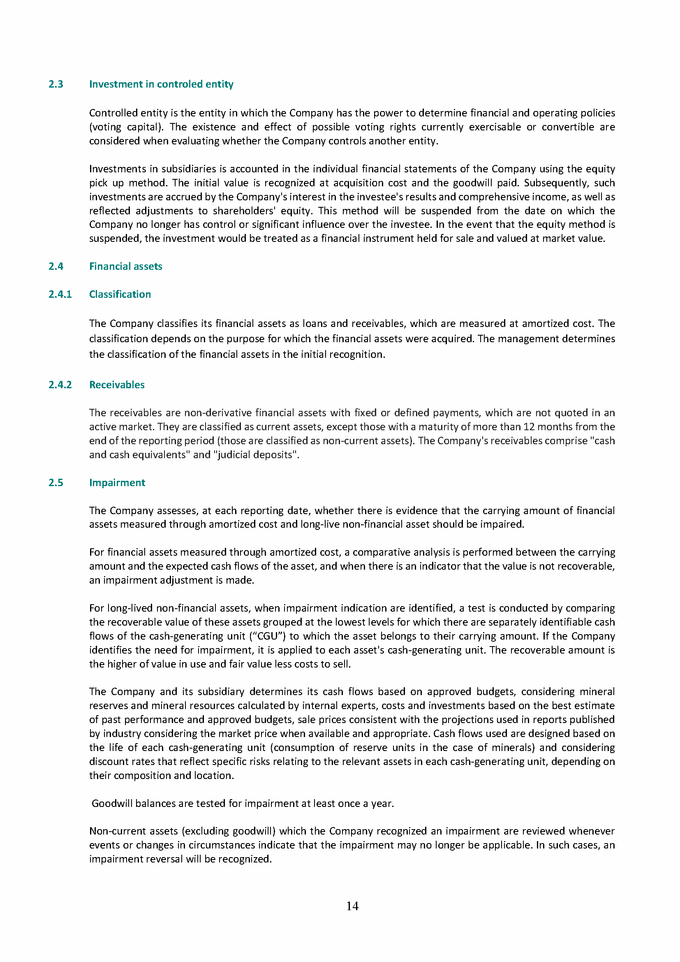
2.6 Allocation of net income and remuneration to shareholders At the end of the year, the Company allocates its net income among dividends and reserves in accordance with the corporate law. For dividends, the Company may use a tax benefit through the modality of interest on capital, respecting the criteria and limits defined by Brazilian legislation. The benefit attributed to the shareholders in this modality is legally considered as part of the annual minimum dividend and therefore is recorded for accounting purposes as remuneration payable in liabilities against retained earnings, based on the Company's bylaws. The distribution of dividends to the Company's shareholders is recognized as a liability in the individual financial statements and is made in accordance with the cash flow received from its subsidiary. 2.7 Provisions Provisions including litigations are recognized when: the Company have a present obligation resulting from a past event, it is probable that the settlement of this obligation will result in an outflow of resources, and the amount of the obligation can be reasonably estimated. Provisions are measured at the present value of the expenditure expected to be required to settle an obligation using a pre-tax rate, which reflects current market assessments of the time value of money and the risks specific to the obligation. The increase in the obligation due to the passage of time is recognized as financial expense. 2.8 Share capital The share capital is represented by non-redeemable common and preferred shares, which are classified in shareholders' equity without par value. The preferred shares have the same rights as the common shares, except for the vote to elect members of the Board of Directors. 2.9 Revenue recognition (a) Equity results from subsidiary Equity results from subsidiary is recognized based on the Company's interest in its subsidiary, applied to its net income. (b) Financial income Financial income is recognized according to the term incurred, using the effective interest rate method. The Company's financial income is basically interest on financial investments and monetary variation of judicial deposits. 2.10 Income taxes Income taxes are recognized in the income statement, except for items recognized directly in shareholders’ equity. The provision for income tax is calculated based on rules and tax rates in force. 2.11 Statement of Value added The Company prepares its value added statement in accordance with the accounting practices adopted in Brazil (CPC 09), which are submitted as part of the financial statements in accordance with Brazilian accounting practices, applicable to public companies. This statement is presented as additional information, without prejudice to the set of financial statements. 15
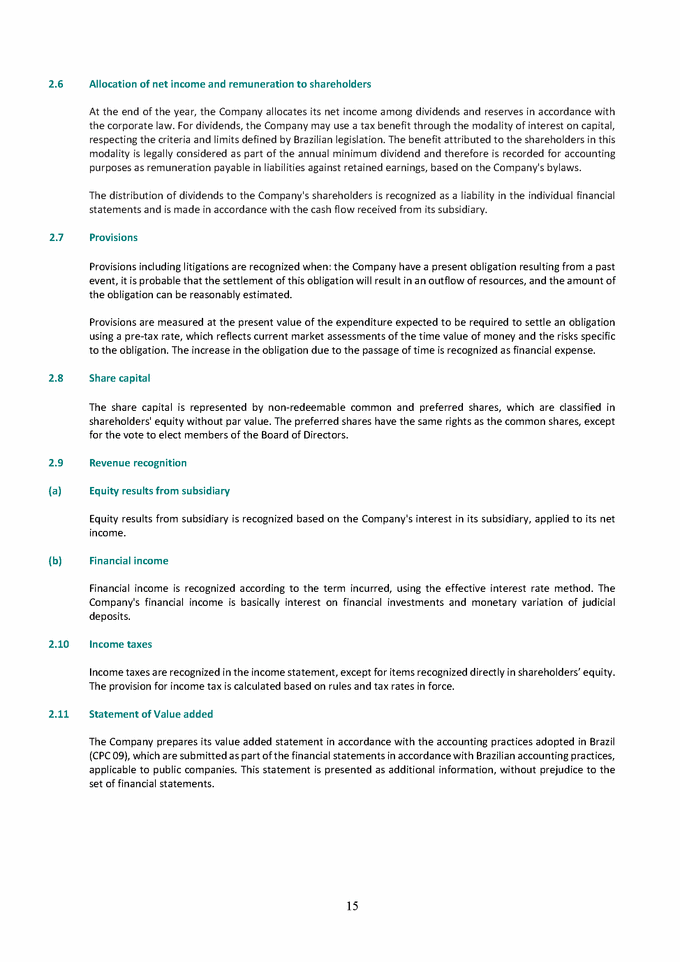
2.12 Risk management The risks to which the Company is exposed derive substantially from Vale's operations. Vale developed its risk management strategy in order to provide an integrated view of the risks to which it is exposed. It assesses not only the impact of the variables traded in the financial market on the results of the business (market risk), but also the risk arising from obligations assumed by third parties towards it (credit risk), those inherent in the productive processes (operational risk) and those arising from liquidity risk. 2.13 New pronouncements The brief description of the recent accounting pronouncements issued by the IASB, which are not yet in force, and the current assessment did by the Company of the impacts on its financial statements, subject to changes due to the more analyzes in progress, are detailed below: IFRS 9 Financial instruments - On July 2014, the IASB issued the final version of IFRS 9 Financial Instruments that replaces IAS 39 Financial Instruments: Recognition and Measurement. This standard brings new approaches about: (is) classification and measurement of financial assets and liabilities, (ii) impairment and (iii) hedge accounting. This standard shall apply for annual periods beginning on or after January 1, 2018. However, the Company still does not have a reasonable estimate of these possible impacts in its financial statements. IFRS 15 Revenue from contracts with customers - On May 2014, the IASB issued IFRS 15, which replaces IAS 18 Revenues and the related interpretations. IFRS 15 introduces the five-step model for revenue recognition from contract with a customer. The new standard is based on the principle that revenue is recognized when the control of a good or service to be transferred to a customer in an amount that reflects the consideration to which the entity expects to be entitled in exchange for those goods or services. This standard shall apply for annual periods beginning on or after January 1, 2018. However, the Company still does not have a reasonable estimate of these possible impacts in its financial statements. IFRS 16 Leases - In January 2016, the IASB issued IFRS 16, which replaces IAS 17 Leases and related interpretations. The IFRS 16 set forth that in all leases with a maturity of more than 12 months, with limited exceptions, the lessee must recognize the lease liability in the balance sheet at the present value of the payments, plus costs directly allocated and at the same time that it recognizes a right of use corresponding to the asset. During the term of the lease, the lease liability is adjusted to reflect interest and payment made and the right to use is amortized, similar to the financial lease settled up in accordance with IAS 17. This standard shall apply for annual periods beginning on or after January 1, 2019. However, the Company still does not have a reasonable estimate of these possible impacts in its financial statements. 2.14 Critical accounting estimates and judgments The presentation of the financial statements in accordance with the principles of recognition and measurement by the accounting standards issued by the CPC requires that the Company's management formulate judgments, estimates and assumptions that may affect the value of the assets and liabilities presented. These estimates are based on the best knowledge and information existing at the balance sheet date and on the actions that are planned to be carried out, being constantly reviewed based on the available information. Changes in facts and circumstances may lead to revisions of estimates, so actual future results may differ from estimates. 2.15 Provision for litigation Contingent liabilities are recorded and/or disclosed unless the possibility of loss is considered remote or possible by our legal counsel. The contingencies are described in the explanatory notes to the financial statements (note 5). 16
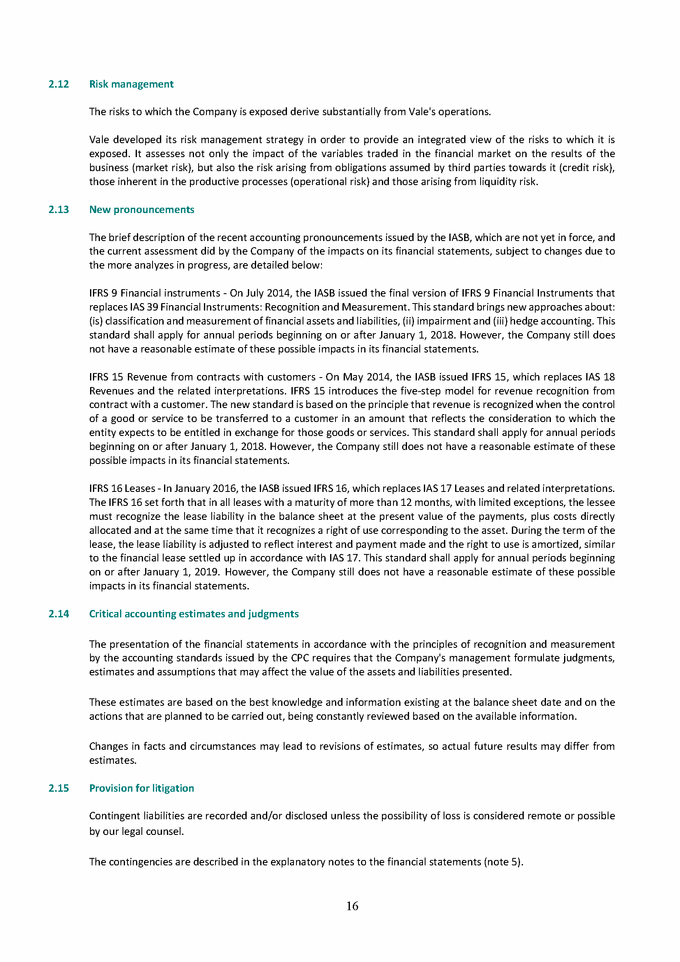
The recording of the contingencies of a particular liability at the date of the financial statements is made when the amount of the loss can reasonably be estimated. By their nature, contingencies will be resolved when one or more future events occur or cease to occur. Typically, the occurrence or not of such events does not depend on our performance, which difficulties to calculate precise estimates about the precise date and that such events will be verified. Evaluating such liabilities involves the exercise of significant management estimates and judgments regarding the results of future events. 3 Cash and cash equivalents 2016 2015 Short-term investments 35,484 9,412 Short-term investments are readily convertible to cash and are indexed to the Brazilian Interbank Interest rate (“DI Rate” or ”CDI”) 4 Investments in subsidiary Changes in investments are as follows: 2016 2015 Reflected adjustments of the subsidiary (4,641,374) 11,453,245 Received interest on capital (288,815) (1,045,124) Proposed interest on capital (877,001) - Goodwill 3,072,669 3,072,669 At December 31, 2016 and 2015, the Company's total participation in the subsidiary Vale is 33.70%. The main balances of the subsidiary are: 290,350,91 5 163,110,39 4 2016 33.70 53.90 127,240,521 14,911,554 13,311,455 17 305,580,17174,419,95(21,957,000(44,212,187 201533.7053.9067131,160,219)) OperatingNet income Vale%%income(loss) of S.A.TotalVotingAssetsLiabilitiesStockholders equity(loss)the year 45,954,89147,275,894 Balance at end of the year42,882,22244,203,225 Received dividends-(648,877) Equity results from subsidiary4,486,187(14,900,259) Balance at beginning of the year44,203,22549,344,240 Total35,6019,460 Cash and bank deposits11748
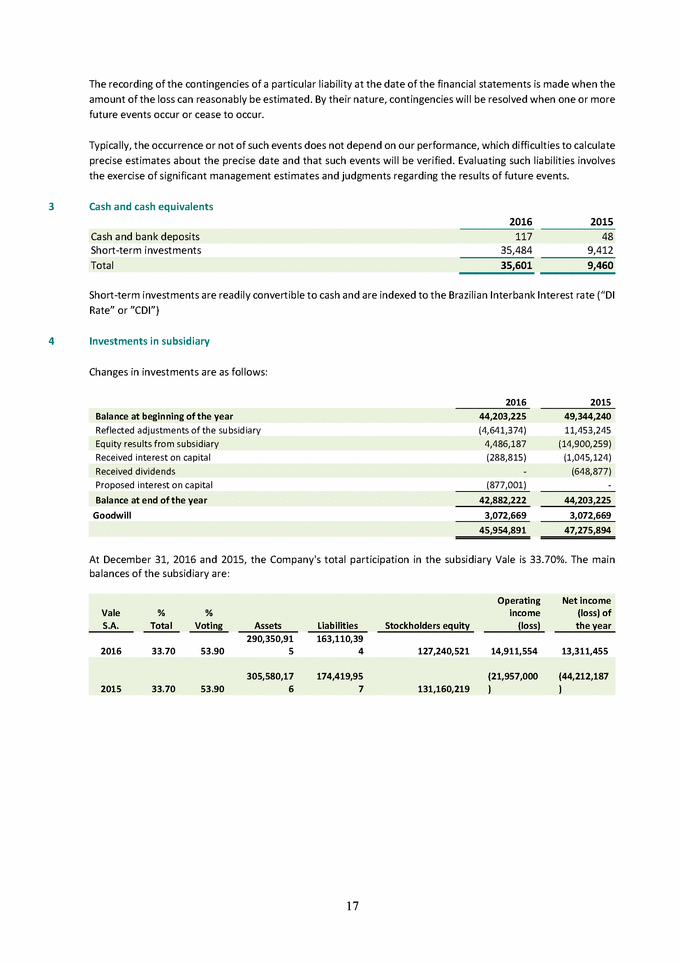
5 Litigation a) Provision for litigation The Company is party to tax ongoing lawsuits, which substantially refer to the non-inclusion of interest on capital revenues in the calculation basis of the non-cumulatives Social Integration Program ("PIS") and Contribution to Social Security ("COFINS"). Changes in provision for litigation are as follows: 2016 2015 Additions - 96,674 Monetary indexation 139,565 949 (*) refers to reversals of tax litigations based on loss estimates measured by the external legal counsel. b) Judicial deposits Valepar made judicial deposits with the objective to suspend the enforceability of tax liabilities, mainly in relation to the lawsuit that does not include interest on equity in the PIS and COFINS calculation bases. In addition, as a subsequent event, on January 25, 2017, Valepar made a judicial deposit in the amount of R$ 26,715 (from the interest on equity received in December 2016) in the writs of the injunction order that discusses the non-inclusion of interest on equity in the calculation bases of PIS and COFINS. Changes in judicial deposits are as follows: 2016 2015 Additions - 96,674 Monetary indexation 171,565 152,469 Related to the amout in the table above, R$533,262 refer to the portion of the judicial deposit that was used to settle the lawsuit included in the federal tax settlement program - REFIS (Note 9) as drescribed in the Brazilian law No. 12,865/13. The lawsuit awaits conversion into income in favor of the Federal Tax Union and subsequent collection of the remaining balance in favor of the Company. c) Contingent liabilities The Company is party in the administrative and judicial lawsuits, for which the estimate of loss indicated by the attorneys-in-fact of the cases is a possible. The possible contingencies of Valepar in the amount of R$773,164 (R$899,768 in 2015) are mainly related to the following discussions: (i) non-inclusion of the Company as a contributor to the Social Contribution on Net Income ("CSLL"), as the Company is not as employer juridical person and the decay of the right of the Brazilian Federal Treasury to constitute the tax credit discussed; (ii) non-inclusion of amounts received as interest on capital in COFINS calculation bases; and (iii) tax lawsuit filed against Valepar for alleged insufficiency of the judicial deposit made in the writs of the injunction order that discusses the non-inclusion of interest on capital revenues in the PIS and COFINS calculation bases. 18 Balance at end of the year2,758,8652,587,384 Reversals(84)-Balance at beginning of the year2,587,3842,338,241 Balance at end of the year1,756,2831,616,718 Reversals (*)-(637,795) Balance at beginning of the year1,616,7182,156,890
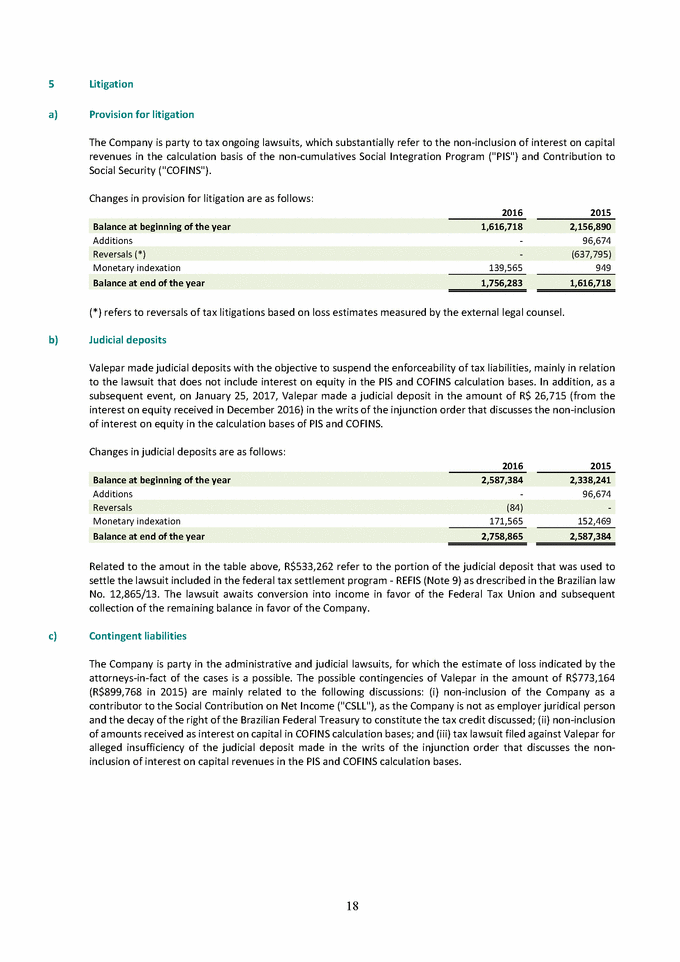
6 Stockholders’ equity a) Share capital On December 31, 2015, a capital increase without share issuance in the amout of R$2,505,500 was approved, referring to the portion of interest on capital. The share capital amounts to R$14,132,725, represented by 1,300,906 thousand common shares and 281,281 thousand class A preferred shares, fully paid and without par value. Common (“ON”) and class A preferred (“PNA”) shares are as follows: SHAREHOLDERS ON % PNA % Litela Participações S.A - - 80,416 29 Bradespar S.A 275,966 21 - - BNDES Participações S.A 149,787 12 - - The Board of Directors may, regardless of statutory review, decide to issue new shares (authorized capital), including through capitalization of profits and reserves up to the authorized limit. b) Profit reserves Legal reserve - is a requirement for all Brazilian private companies and represents the appropriation of 5% of annual net income based on Brazilian law, up to 20% of the share capital. In 2016, the Company constitutes legal reserve in the amount of R$224,602. In 2015 due to the Company's loss, no legal reserve was constituted. Profit reserve to realize - constituted due to existing profits in which are financially not available, resulting from the adjustments of the investment by the equity method. This reserve will be distributed as dividends to the extent that the profits are realized or become financially available. In 2016, the Company constituted profit reserve to realize in the amount of R$3,978,625. In 2015 the Company realized R$15,287,661 of that reserve to absorb losses and remuneration of the shareholders. c) Interest on capital Valepar's by-laws determine that the distribution of dividends and/or interest on capital will not be less than 100% of the dividends and/or interest on capital received from Vale, less the Company's expenses. In 2016, Valepar received from Vale the amount of R$288,815 and proposed the distribution in the same amount. Changes in interest on capital are as follows: 2016 2015 Proposal of distribution 245,493 807,500 Capital increase - (2,505,500) 19 Balance at end of the year31,215-Payment(214,278)(189,000) Balance at beginning of the year-1,887,000 TOTAL1,300,906100281,281100 Mitsui & Co., Ltd.237,32818--Eletron S.A381---Litel Participações S.A637,44449200,86571
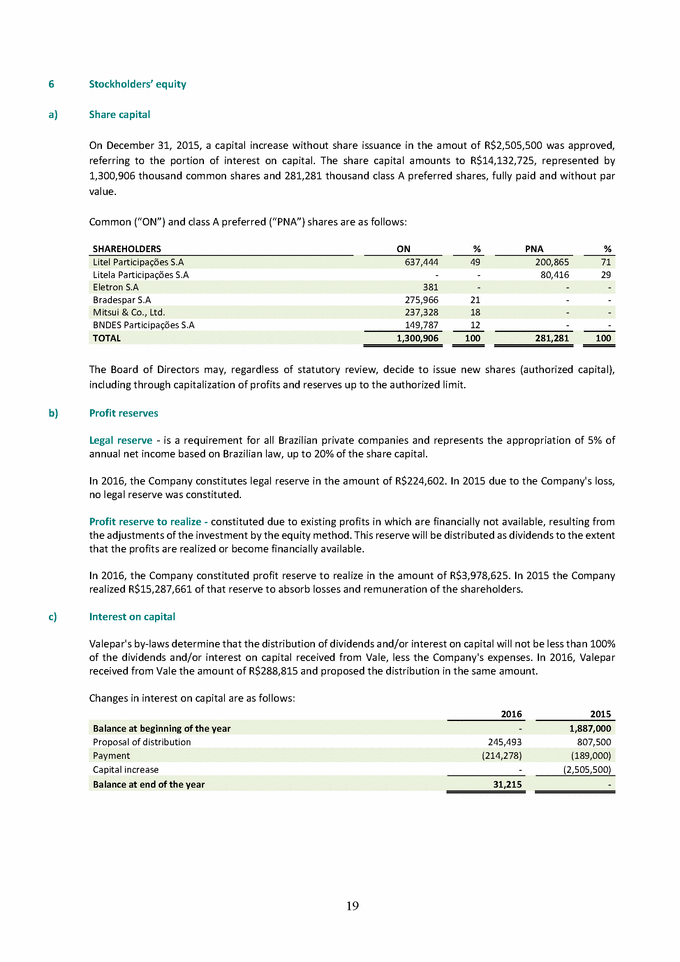
d) Basic and diluted earnings per share Basic and diluted earnings per share were calculated as follows: Net income (loss) 4,492,042 (14,337,161) Income (loss) available to preferred shareholders 798,595 (2,548,859) Total 4,492,042 (14,337,161) Weighted average number of shares outstanding – common shares 1,300,906 1,300,906 Basic and diluted earnings per preferred shares 2.84 (9.06) e) Reflected equity adjustments The amounts set below represented the reflected adjustments of Vale: Acquisitions and disposal of noncontrolling shareholders Result in subsidiary’s interest variation Retirement benefit obligations Cash flow hedge Translation adjustments Gain (loss) total Others Other comprehensive income 87 491 11,596 (722) - 1 11,453 Other comprehensive income (89) 9 (4,566) 4 - 1 (4,641) 7 Financial instruments The Company has assessed its assets and liabilities in relation to its realization through available information and valuation methodologies established by management. The carrying values of the main financial assets and liabilities of the Company as of December 31, 2016 and 2015 are close to the recoverable value. The Company did not contract derivative financial instruments in 2016 and 2015. The company performed the impairment test with the purpose of verifying recoverability of the goodwill of its investment and did not identify the need for any impairment of its value. 8 Financial results Financial expense 2016 2015 Monetary restatement (139,565) (949) Others (1,681) (1,689) Financial income Short-term investments 1,082 1,880 Total 181,253 161,579 20 Financial results, net38,75958,951 Others8,6067,229 Monetary restatement171,565152,470 Total(142,494)(102,628) REFIS expense(1,248)(1,202) Interest on redeemable shares-(98,788) Balance at December 31, 2016(673)3715,174(1,052)(1,024)7012,532 Balance at December 31, 2015(584)2819,740(1,056)(1,024)6917,173 Balance at December 31, 2014(671)(463)8,144(334)(1,024)68 5,720 Basic and diluted earnings per common2.84(9.06) Total1,582,1871,582,187 Weighted average number of shares outstanding – preferred shares 281,281281,281 Income (loss) available to common shareholders3,693,447(11,788,302) Basic and diluted earnings per share: 20162015
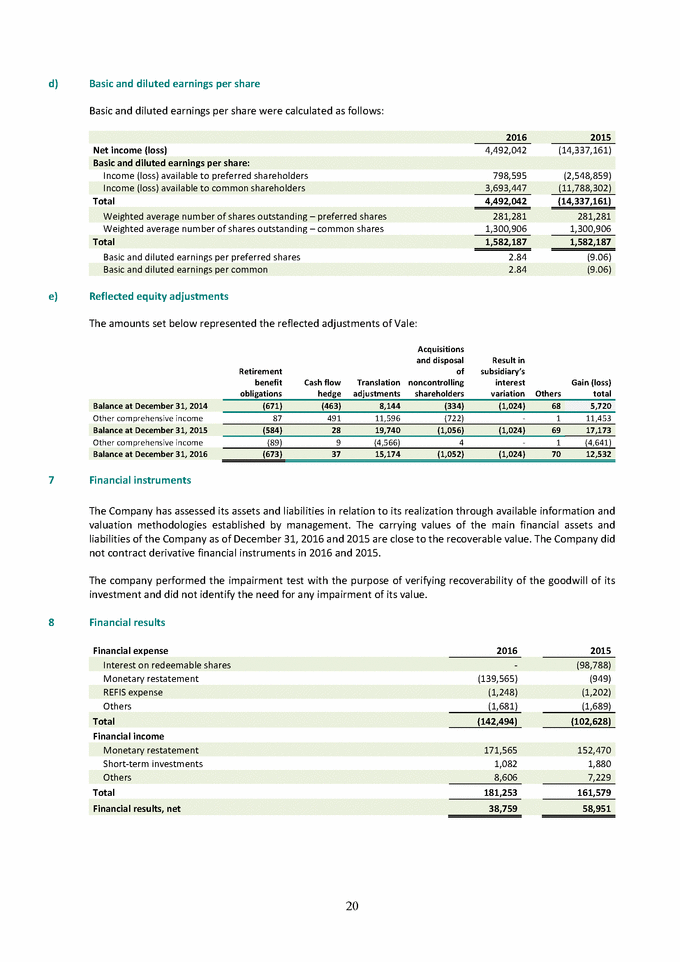
9 Accounts payable - REFIS In October 2013, the Company elected to participate in the Income Tax Settlement Program (“REFIS”) related to tax debits due to November 30, 2008. Under REFIS conditions, the tax debits were included as follows: (i) upfront payment with 100% reduction of penalty, interest and other legal charges; or (ii) in, 30, 60, 120 or 180 monthly installments, with 60% to 90% reduction of penalty, 45% to 25% reduction of interest, and the possibility to use tax losses and negative social contribution for the discharge of fines and interest, including tax debits guaranteed by judicial deposit. Valepar has lawsuits related to the PIS and COFINS on interest on capital received, in two security orders, with distinct grounds, as follows: i) requesting the exemption of PIS and COFINS on interest on capital as the exemption given to dividends, since these have the same legal nature; and ii) requiring isonomy, since some companies - maintained in the cumulative system of PIS and COFINS or established abroad - would not be required to collect PIS and COFINS on amounts in the form of interest on capital as required by Valepar. In December, 2013, considering the substantial reduction of the amounts in dispute, and that both cases were in a second instance decision unfavorable to Valepar, pending a Superior Court decision, the Company decided to partially elect REFIS to pay the amounts related to PIS and COFINS levied on the interest on capital received controlled in the administrative proceedings with the Brazilian Internal Revenue Service. In 2016, the writs of the injunction order filed in 2007 ended in an unfavorable manner to the Company, following the judgment of a leading case of the issue. With the prevalence of the thesis that interest on capital can not be equated to dividends, and therefore, it composes the basis of calculation of the PIS and COFINS contributions. They concluded that Brazilian Law No. 10,637/2002 and Brazilian Law No. 10,833/2003 define as the basis for calculating PIS and COFINS the total revenues earned by the legal entity, regardless of their accounting assignment. The judicial deposits are related to other lawsuit of 2011 and that its still in process, but the estimate of loss is also probable. On December 31, 2016, the balance of REFIS is R$415,747 (R$993 as current and R$414,754 as non-current). The amount R$ 404,000 will be settled using judicial deposit, as mentioned in note 5.b and the remaining balance is due in 143 monthly installments. 10 Income taxes The total amount presented as income taxes in the income statement is reconciled to the rate established by law, as follows: Net income (loss) before income taxes 4,493,055 (14,303,582) Equity results from subsidiary 1,525,304 (5,066,088) Adjustments to transitional taxation law - interest on redeemable shares - (33,737) Others (390) 154 11 Key management personnel remuneration The management total remuneration of the Company was R$1,042 in 2016 (R$726 in 2015). 12 Subsequent event On February 20, 2017, Valepar announced that a new stockholders’ agreement was executed by its stockholders Litel Participações S.A., Litela Participações S.A., Bradespar S.A., Mitsui & Co., Ltd. and BNDES Participações S.A. – BNDESPAR (“Stockholders”), which shall enter into force after the expiration of Valepar’s current Stockholders’ Agreement on May 10, 2017. 21 (1,013)(33,579) Exclusion of non-deductible expenses1,712235,216 Revenue in excess to the interest on capital expense-(32,342) Adjustments that affect the basis of income taxes: Income taxes at statutory rates - 34%(1,527,639)4,863,218 20162015
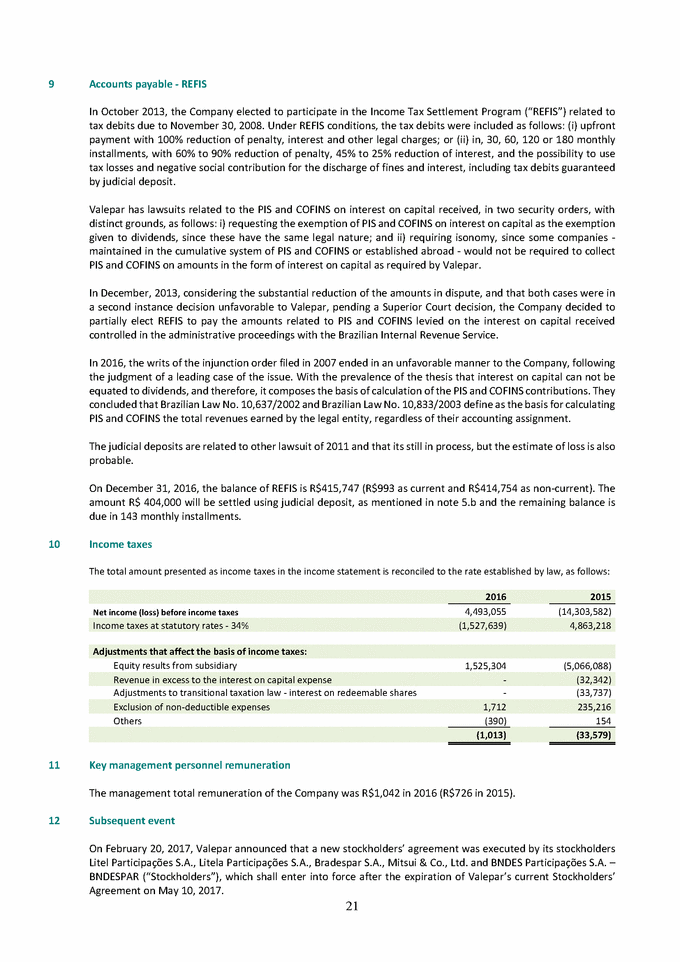
The new agreement, along with the standard provisions in connection with voting rights and right of first refusal for the acquisition of the Stockholders’ shares, provides of the presentation by the Stockholders of a proposal to Vale for the purpose of enabling the listing on BM&FBOVESPA’s Novo Mercado special segment (Brazil) and making Vale a company without defined control (“Proposal”). The Proposal is binding on the Stockholders, and it is subject to approval by Vale’s corporate bodies. The agreement will have a term of 6 months, counting from the date it takes effect. The transaction envisaged by the Proposal is composed of a series of indivisible and interdependent steps, whose effectiveness is subject to the successful performance of the other steps. The Proposal comprises, beyond the performance of all acts and procedures imposed by the applicable legal provisions and rules: (i) Voluntary conversion of Vale class A preferred shares into common shares, based on the conversion rate of 0.9342 common shares for each Vale class A preferred share, based on the average closing price of the common shares and preferred shares over the last 30 trading sessions on the BM&FBOVESPA prior to February 17, 2017 (inclusive), weighted by the volume of shares traded in such trading sessions; (ii) Amendment of Vale’s bylaws, so as to adjust it, as much as possible, to BM&FBOVESPA’s Novo Mercado special segment rules so Vale may be effectively listed on such special segment; (iii) The merger of Valepar into Vale at an exchange ratio that contemplates a 10% increase in the number of shares held by the shareholders of Valepar compared to Valepar’s current shareholding interest, and represents a dilution of approximately 3% of the shareholding interest held by the other shareholders in Vale. In connection to the provisions of item “iii” above, Valepar’s shareholders will receive 1.2065 Vale common shares for each Valepar share held by them. As a result, Vale will issue 173,543,667 new common shares, all registered and without par value, in favor of Valepar’s shareholders. Consequently, Valepar’s shareholders will own a total of 1,908,980,340 Vale common shares after the merger of Valepar. The goodwill balance carried on Valepar’s financial statements and its potential tax benefit use by Vale will not be subject to capitalization in favor of Valepar’s stockholders, but will be for the benefit of all Vale’s shareholders. The implementation of the Proposal is subject to (i) the approval of the Proposal, including the merger of Valepar into Vale, by Valepar’s and Vale’s corporate bodies; and (ii) the acceptance by at least 54.09% of class A preferred shares of the voluntary conversion, as mentioned above, within the maximum term of 45 days from the stockholders’ meeting decision on the matter, resulting in a combined shareholding interest held by the Stockholders of less than 50% of Vale’s total common shares. Valepar and the Stockholders will not exercise their voting right at Vale’s shareholders’ meetings that consider the voluntary conversion of the Vale class A preferred shares into common shares and the merger of Valepar. The holders of American Depositary Shares representing class A preferred shares of Vale will be able to elect voluntary conversion into American Depositary Shares representing common shares of Vale, on the same terms available to holders of class A preferred shares. Class A preferred shares, and preferred ADSs, that do not elect voluntary conversion will remain outstanding. On the date of effectiveness of the merger of Valepar into Vale, if the merger is approved, the Stockholders will execute a new stockholders’ agreement (“Vale Agreement”) that will bind only 20% of the totality of Vale’s common shares, and will be in force until November 9, 2020, with no provision for renewal. For 6 months from the date of entry into force of the Vale Agreement, the Shareholders will be obligated not to transfer, by any means, either directly or indirectly, Vale shares they receive as a result of the implementation of the Proposal (“Lock-Up”), except for (i) the transfer of Vale’s shares by the Shareholders to their affiliates and their current shareholders, provided that such transferred shares shall remain subject to the Lock-Up, and (ii) the transfer of shares held by the Shareholders prior to the merger of Valepar. 22
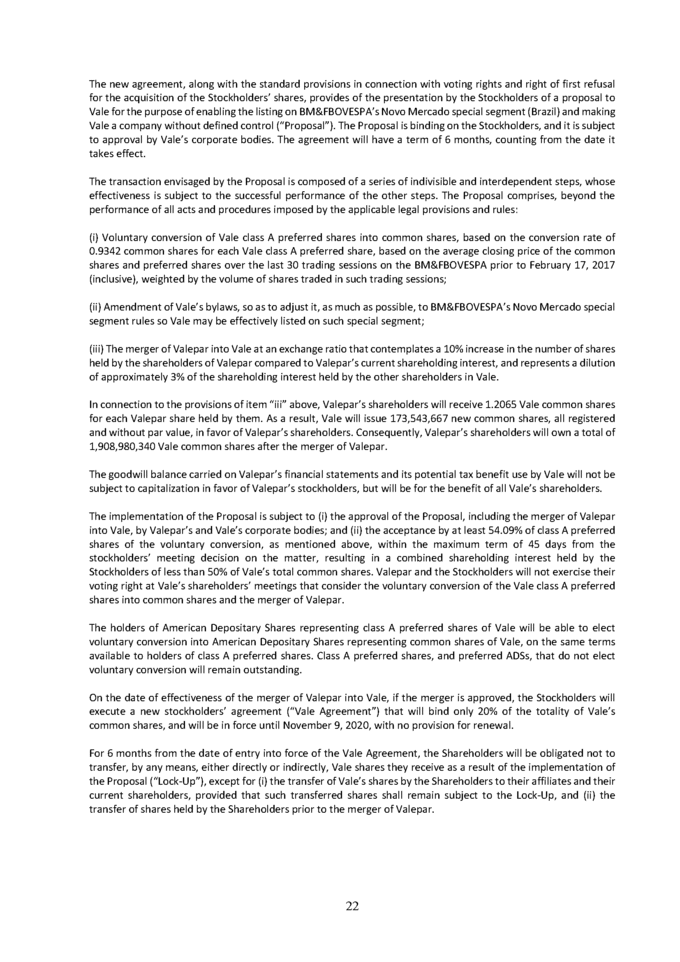
13 Members of the Board of Directors and Directors Board of Directors Dan Antonio Marinho Conrado President Fernando Jorge Buso Gomes Vice-president Arthur Prado Silva Marcel Juviniano Barros Gilmar Dalilo Cezar Wanderley Márcia Castro Moreira Carlos Antonio Vieira Fernandes Moacir Nachbar Junior Denise Pauli Pavarina Shinichiro Omachi Eduardo de Oliveira Rodrigues Filho Paulo Sergio Moreira da Fonseca Directors Gueitiro Matsuo Genso President-director Fernando Jorge Buso Gomes Director Dioni Barboza Brasil Accounting Manager TC-CRC-RJ 083305/O-8 * * * 23
